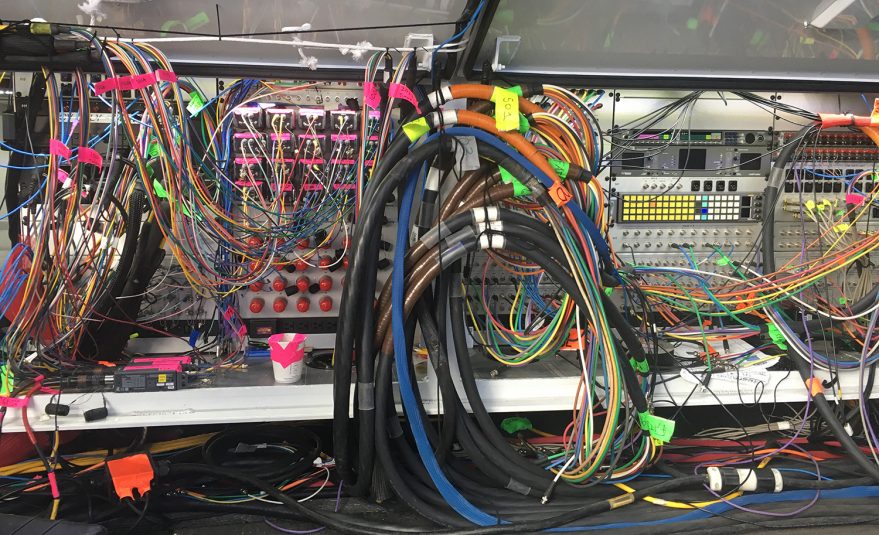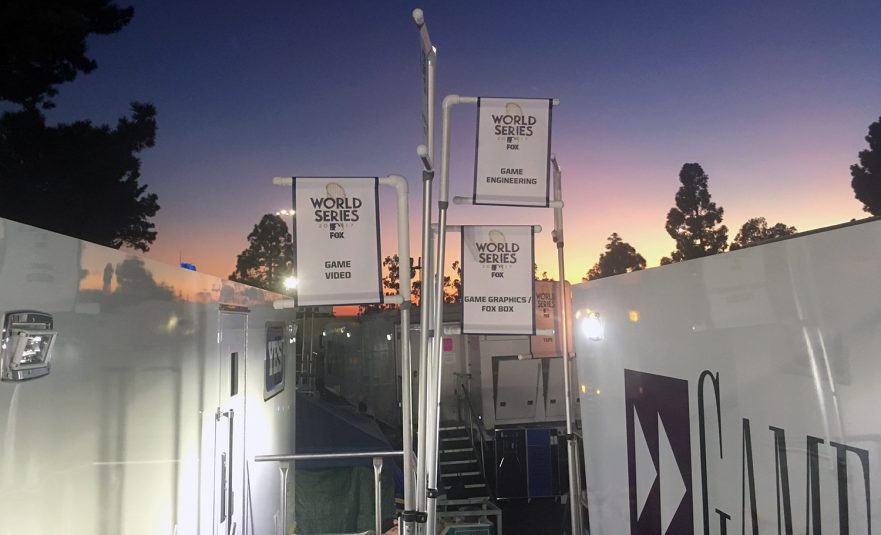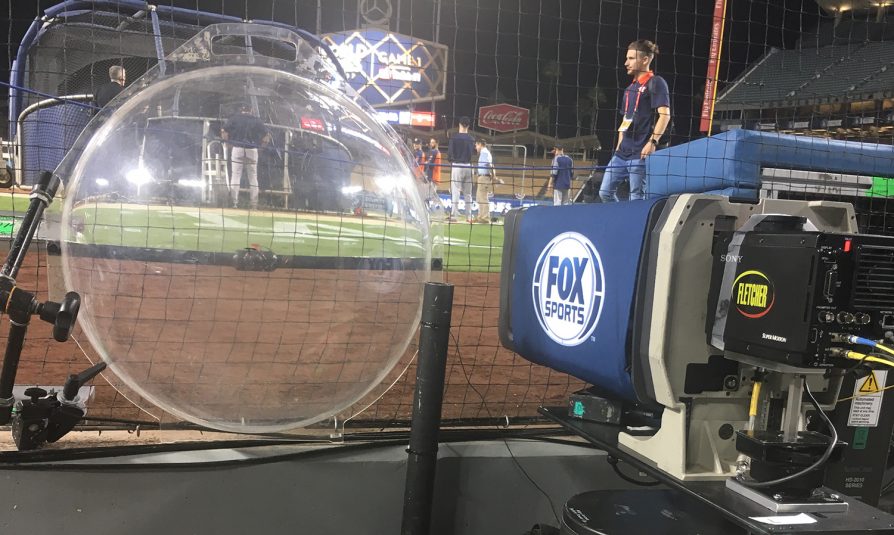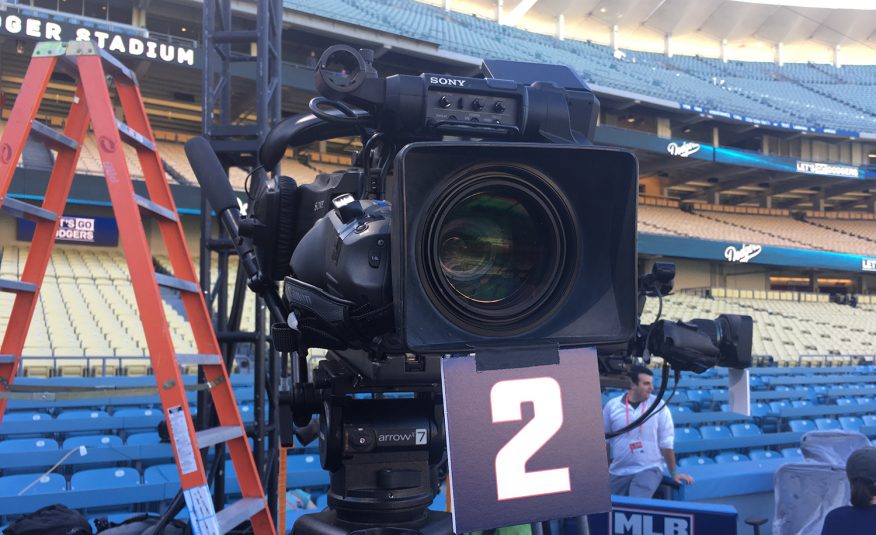Fox Sports Enters 20th World Series on a Ratings, Technology High Note
Its massive gear complement includes 40+ cameras, 6+ slo-mos, and 14 underground mics
Story Highlights
Coming off the most-watched LCS game since 2010 (Saturday’s ALCS Game 7 on FS1) and the most-watched MLB Postseason overall since 2011, Fox Sports is riding plenty of ratings momentum into tonight’s World Series opener at Dodger Stadium. With more eyeballs expected to tune in, Fox will bring its technology A game to the Astros-Dodgers series, including 40-plus cameras (a record eight high-speed cameras), 15-plus underground mics on the field, a new in-perspective virtual–strike-zone graphic, and the World Series debut of Game Creek Video’s Yogi mobile unit.
“This postseason has been great for us not only because we’ve gotten some really compelling matchups that people want to watch but we’ve also had great crews, great trucks, and some pretty exciting new tools to work with,” says Brad Cheney, VP, field operations and engineering, Fox Sports. “This year, we made an effort to up our resources not just for the World Series but also for the LDS and LCS. The LCS and the World Series [production complements] really don’t differ a lot. And that’s by design: we have been able to beef up the LCS to a World Series level.”
Camera Complement: Full High-Speed Ahead
Fox’s 40-plus–camera complement will include more high-speed cameras than ever: five Sony HDC4300 6X slo-mos (360 fps) at low third, inside low first, right center, mid third, and tight tight center; a Sony HDC-4800 16X slo-mo (960 fps) at mid first; and two Inertia Unlimited X-Mo Phantom cameras at low first and low third to capture dramatic shots of swings at the plate. In addition, since Dodger Stadium is among the few ballparks to feature a true low-home position, Fox will deploy an additional HDC-4300 to capture tight shots of the pitcher’s face and slow-motion shots on the mound.
“We’re really excited to get low home back in L.A. and to make it a super-motion camera,” says Cheney. “When you think back to those classic World Series games [of the 1990s and 2000s], you think of the tight, intense face shots of Pettitte, Clemens, Pedro, and others about to throw the ball and capturing that ball coming at you. It’s an amazing look, and we’re so excited to have it back. And having it at 360 fps is going to make the picture pop even more.”
Fuji had the main show cameras in Houston (11 99x and 3 101x), however we spotted in 2 XJ86x9.3 and Fletcher used same compliment in Houston as in LA.

Fox Sports linked its main compound and studio compound, which were 2,200 ft. apart, via fiber. In addition, Fox ran nearly 20 miles of fiber for its production throughout Dodger Stadium, a triax-based facility.
CP Communications is providing a pair of roving RF handheld cameras and an additional roving RF on a MōVI three-axis stabilized gimbal, which has captured innumerable dramatic shots of hitters rounding third after a homer and pitchers walking to the dugout after a third-out strikeout this Postseason.
All robos are being provided by Fletcher, including Sony HDC-P1R’s at mid home, inside both dugouts, two beauty shots, and the booth camera. In addition, Fox will use locked-off POV cameras from Inertia Unlimited in both bullpens.
Fox has a full Canon lens complement in LA: 10 XJ95x8.6, one XJ86x9.3, and three XJ75x9 box lenses; three HJ24ex7.5, four HJ22ex7.6, and two HJ14ex4.3 ENG lenses; and two XJ95x8.6, one HJ24ex7.5, and one HJ40x10 on Fletcher robos. In Houston, Fox will have 11 Fujinon 99x and three 101x lenses, as well as two XJ86x9.3 Canon lenses and the same Canon lens complement for Fletcher robos.
Audio: Fox’s Team Returns for More October Glory
Not to be overshadowed by the gargantuan camera complement, Fox’s Emmy Award-winning audio team will be out in full force with 120-plus total microphones, including 16 underground mics on the field (potentially as many as 20), 80-plus game-action microphones, and 15-20 mics available for managers, coaches, umpires, and players.
“We’ve upped the ante again for audio in the World Series and, actually, even more for Games 6 and 7 in L.A. — should it get that far,” says Cheney. “We will have at least 16 field mics, and we’re looking potentially to even push it to 20, depending on a few factors. The [on-field] mics have been great; we’ve heard people sliding around the outfield that you normally would have never heard. [A1 Joe Carpenter] and his audio team are really on top of it once again.”
With so many on-field mics, Fox is careful to avoid allowing offensive language to slip into its telecasts. Carpenter and his team have created a complementary mix that allows them to dump out of the on-field mics but retain the remaining audio sources to create a seamless (and curse-free) audio experience for viewers.
The Calrec Brio audio consoles that Fox Sports invested in prior to the U.S. Open golf tournament this past summer will be on hand, along with the World Series debut of the Calrec Hydra2 audio network
Graphics: A New Strike-Zone Perspective, Vizrt Laptops
Fox Sports will also continue to use the in-perspective strike zone, developed in conjunction with SMT and MLBAM, for both live action and replays during the Series.
SMT provides a live strike zone that incorporates data captured via MLBAM Statcast radar technology. The data shows pitch speed and location in real time. For replay sequences, Fox Sports is using MLBAM’s Pitchcast system, which made its debut during the ALDS and displays pitch speed, location, and ball trails, splitting the data into different varieties.
“We teamed up with SMT and MLBAM to provide this very cool new strike zone, and it’s been great for our broadcast,” says Cheney. “All the feedback has been good, and the workflow’s excellent because SMT was able to provide this as part of their normal virtual advertising and strike-zone system. So there are no additive layers, processes, or delay.
In addition, SMT is providing center-field virtual advertising from Fox’s high-home camera in a World Series first.
At the outset of the Postseason, Fox launched a new MLB scorebug and graphics look designed by Fox Sports EVP, Graphics, Gary Hartley and his team. At the same time, Fox graphics operators onsite transitioned from traditional Vizrt CG workstations to laptops with Vizrt software. During the World Series, Fox will have two operators running two graphics channels apiece from the laptops (plus a scorebug operator). The only traditional Viz machine onsite will be on hand as a backup.
“It’s amazing to say, but our Vizrt [machines] are now just laptops,” says Cheney. “[SVP, Graphics Technology and Integration,] Zac Fields and his crew worked with [vendor TV Graphics] to build some breakout boxes to feed the video into the laptops, but we are using them on the air as our main machines, and it’s been great. It’s portable, easy to use; it helps on shipping, and they can build shows on real machines during downtime and travel.”
Inside the Truck: Yogi Makes World Series Debut
Game Creek Video’s Yogi is making its World Series debut for the L.A. games, following a successful LDS and ALCS run, MLB All-Star Game appearance in Miami, and its first year as the main truck for New York Yankees broadcasts on YES. Yogi is built around an Evertz EXE IP router and worked Fox’s 4K productions of ALCS Games 3 and 4 alongside Game Creek’s Chesapeake truck, home to a separate technical director, A1, and video team unique to the 4K show.
“Yogi’s been phenomenal so far,” says Cheney. “The B unit happens to be a dual-feed type setup, and we converted that side of it so that all of our replay operations are in the B unit with plenty of space and a lot more monitoring.

Game Creek Video’s A and B units are on hand at the Dodger Stadium compound for Fox’s World Series production.
“And then,” he continues, “having the IP router has been great because we’ve been able to use Game Creek’s remote IPG kit to extend Yogi’s capability to tie into Chesapeake for the ALCS 4K shows. We’re extending our Dante audio, and pretty much all of our cameras are now Sony 4300’s or higher. Yogi has let us take it to the next level.”
In addition to Yogi, Game Creek has rolled out Chesapeake A to produce the on-site studio show in L.A., along with its Edit 2 and B2 support trucks. In Houston, NEP’s EN2 A & B units (home to ESPN’s Sunday Night Baseball during the regular season) will work the games, while NEP’s NCP14 houses the studio show and ATU is on hand for support. UPS Power for the compound is being provided by CAT EntertainmentServices in both cities.
In total, Fox will have 64 EVS record channels, 32 playback channels, and 2,000-plus hours of recording capacity at its disposal in the truck facilities.
File Transfer: Connectivity to the Broadcast Center Continues To Grow
Fox Sports’ file-exchange workflow between remotes and its Los Angeles broadcast center continues to grow each year. For the Series, in addition to two Level 3 Vyvx video circuits for the primary and backup feeds, Fox has deployed four paths on its private Venue Access Network (a first for a World Series), which allows its facilities in L.A.; The Woodlands, TX; and Charlotte, NC; and its Fox Sports Regional Networks to pick up the feeds. As part of that 1-Gbps connection, Fox has 400 Mbps of private networking for file transfer. In addition, Fox is using a Level 3 1-Gbps IP public-internet line for its Broadcast Data Network (BDN), which handles its Signiant file transfer and provides general-internet connectivity onsite, RTS RVON comms, and phones connected into the L.A. facility.
“It’s been a big goal at Fox to continue to push the level of data transfer that we’re doing,” says Cheney. “The bonus of what’s been installed by a lot of vendors is true IP connectivity, and we’re trying to leverage that as much as we can.”
Fox Sports’ 20th year of World Series begins with Game 1 from Dodger Stadium tonight at 8:09 p.m. ET on Fox.


